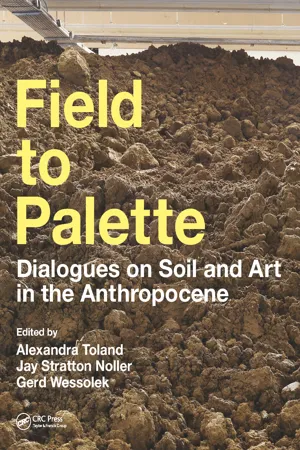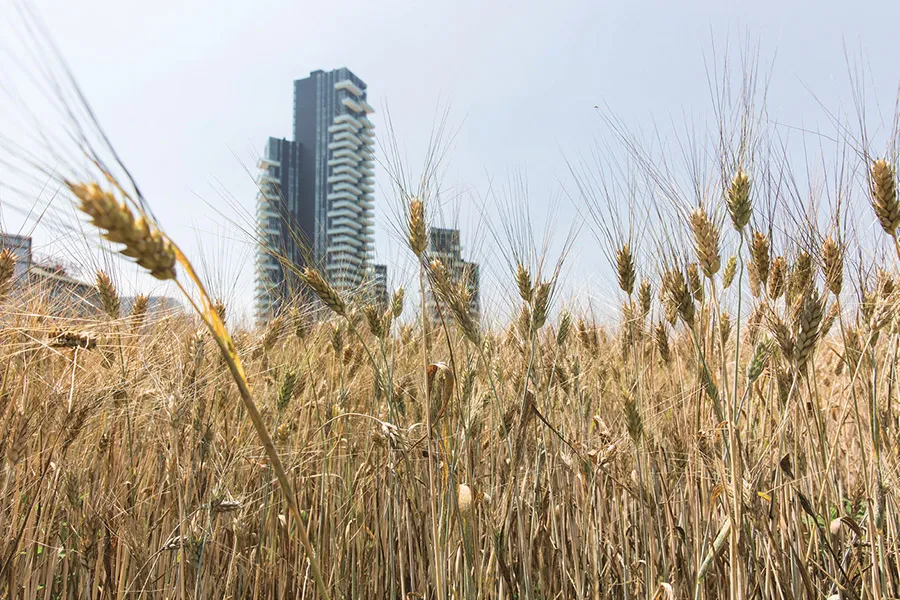Function 1
Sustenance: Soil as provider of food, biomass and all forms of nourishment
Sustenance
The first section of the book introduces the most widely recognized function of the soil—that as great provider. Approximately three-quarters of the Earth’s surface is covered by water and only about half of the remaining quarter of land surface is available for human use. Of that land available for human use, three-quarters is either too rocky, too wet, too dry, too hot, or too cold for food production. An estimated ninety-nine percent of human nourishment comes from that last remaining three percent of available land. Despite this already slim margin of available land, the Food and Agriculture Organization of the United Nations (FAO) has warned that over a third of this land is already “moderately to highly degraded through erosion, salinization, compaction, acidification, chemical pollution and nutrient depletion.” (See reference on Soil Solutions website cited December 1, 2017: https://soilsolution.org/10-soil-facts/.) This section of the book presents the production function of soil as a critical factor in human existence.
The section opens with one of the most iconic artworks of the twentieth century, Agnes Denes’ Wheatfield—A Confrontation. The revered eco-art pioneer Agnes Denes exchanges views on soil, hunger, and world peace with the esteemed president of the International Union of Soil Sciences, Rattan Lal. Terroir is conceptually explored as a means of communicating soil’s productive capacity in chapters by Laura Parker and Tom Willey, Lou Preston and Scott Burns, an interview with Brent Clothier and Matthew Moore by Alexandra R. Toland, and a recipe for a hearty root stew by star chef and sustainable soil activist Sarah Wiener. Meal culture is proposed as an alternative concept to soil and food security in the chapter by Parto Teherani-Krönner and Roxanne Swentzell, who argue for more attention to feminist and indigenous perspectives in soil protection debates. Problematic issues of agricultural industrialization, disrupted nutrient cycles, pollution, and the Anthropocene are brought up in chapters by Maria Michails and Ronald Amundson, and Bonita Ely and Richard MacEwen. As an antidote to these, experimental solutions in human waste recycling, urban “black gold” composting and artistic soil building are offered in chapters by Valentina Karga, Ayumi Matsuzaka and Stephen Nortcliff; Tattfoo Tan; and Sue Spaid.
Agnes Denes was born in Budapest, raised in Sweden, educated in the United States, and began her artistic career in the 1960s. One of the most prominent artists of our time, Denes is internationally known for works investigating science, philosophy, linguistics, psychology, poetry, history, and music, created in a wide range of mediums. Denes has had three museum retrospectives and participated in more than 600 exhibitions at prominent galleries and museums throughout the world including, among others, the Corcoran Gallery of Art, Washington, D.C. (1974); the Ludwig Museum, Budapest, Hungary (2008); the Biennale of Sydney (1976); documenta 6 and 14, Kassel, Germany (1977 and 2017); the Venice Biennale (1978); and Ends of the Earth: Land Art to 1974, Museum of Contemporary Art, Los Angeles (2012). She has completed public and private commissions in North and South America, Europe, Australia, and the Middle East, and has received numerous awards including four fellowships from the National Endowment for the Arts; the Eugene McDermott Award from MIT (1990); the Rome Prize from the American Academy in Rome (1998); the Ambassador’s Award for Cultural Diplomacy (2008) from the American Embassy in Hungary; and she was a Fellow at the Massachusetts Institute of Technology (MIT) and Carnegie Mellon University and received a Guggenheim Fellowship in 2015. Denes holds honorary doctorates from Ripon College and Bucknell University, and lectures extensively at colleges and universities throughout the United States and abroad, and participates in global conferences on art, the environment, and the human condition. She is the author of six books and is featured in numerous other publications on a wide range of subjects.
Rattan Lal is a Distinguished University Professor of Soil Science and director of the Carbon Management and Sequestration Center, Ohio State University. With completion of education from Punjab Agricultural University, Ludhiana (BSc, 1963); Indian Agricultural Research Institute, New Delhi (MSc, 1965); and Ohio State University, Columbus (PhD, 1968), he served as a senior research fellow with the University of Sydney, Australia (1968–1969), Soil Physicist at IITA, Ibadan, Nigeria (1969–1987), and Professor of Soil Science at OSU (1987–present). His current research focus is on climate-resilient agriculture, soil carbon sequestration, sustainable intensification, enhancing use efficiency of agroecosystems, and sustainable management of soil resources of the tropics. Lal received the Hugh Hammond Bennett Award of the SWCS, 2005; Borlaug Award (2005) and Liebig Award (2006) of the International Union of Soil Sciences; as well as honorary degrees from Punjab Agricultural University (2001), the Norwegian University of Life Sciences, Aas (2005), Alecu Russo Balti State University, Moldova (2010), Technical University of Dresden Germany (2015), and University of Lleida, Spain (2017). He is currently president of the International Union of Soil Sciences. Among other posts, he was a member of the Federal Advisory Committee on National Assessment of Climate Change, NCADAC (2010–2014) and senior science advisor to the Global Soil Forum of IASS, Potsdam, Germany (2010–2012). Lal was a lead author of IPCC (1998–2000), and has authored/coauthored more than 868 refereed journal articles and 506 book chapters, and has written 20 and edited/coedited 68 books.
We invited Agnes Denes and Rattan Lal, two iconic figures in their own fields, to talk about their opinions on the future of urban agriculture. Bringing their voices together in one chapter is symbolic. Denes has been involved in several high-profile soil-related projects, including Tree Mountain—A Living Time Capsule, a monumental earthwork reclamation project in Ylöjärvi, Finland, and Mathematical Forest in Melbourne, Australia, consisting of 6000 endangered species. Denes’ artistic practice is distinctive in terms of its engagement with aesthetics and highly visible socio-political impact. Tree Mountain, for example, was dedicated by the president of Finland upon its completion in 1996 and is legally protected for the next four hundred years.
As current president of the International Union of Soil Sciences and 2007 recipient of the Nobel Peace Prize Certificate by the IPCC, Professor Lal is a respected authority on the global mission to secure soil health and food sovereignty, especially as populations in urban centers continue to rise. According to Lal, healthy soil is not only integral to the stability and prosperity of nations around the globe, but is a key to world peace. Now more than ever, issues of social justice and environmental degradation associated with globalized industrial agriculture demand innovative answers from the sciences and arts. It is impossible to talk about feeding the world without imagining productive cities contributing to people’s daily diet of grains, fruits, vegetables, and animal products.
The outgoing vision for the conversation begins with Denes’ 1982 groundbreaking intervention, Wheatfield—A Confrontation, one of the first land artworks to address issues of food, energy, and world hunger. The site of Wheatfield was and is simultaneously a canvas, a commodity, a common good, a place of waste deposition adapted for food production, and a place of confrontation on many levels. Recently reenacted in Milan in collaboration with the fondazione nicola trussardi on occasion of the 2015 World Expo and International Year of Soils, Wheatfield provides a lens with which to imagine productive cities of the future and the soils that lie beneath.
Through a series of e-mail conversations, Lal and Denes generously shared their views on the future of soil health and the philosophical and political will needed to feed a hungry planet. In the preparation of the chapter, Denes invited her former agronomist helper and adviser for Wheatfield, John Ameroso, to share some of his on-the-ground insight about the project. His comments are included here, as well as Denes’ original philosophical statement about Wheatfield.


